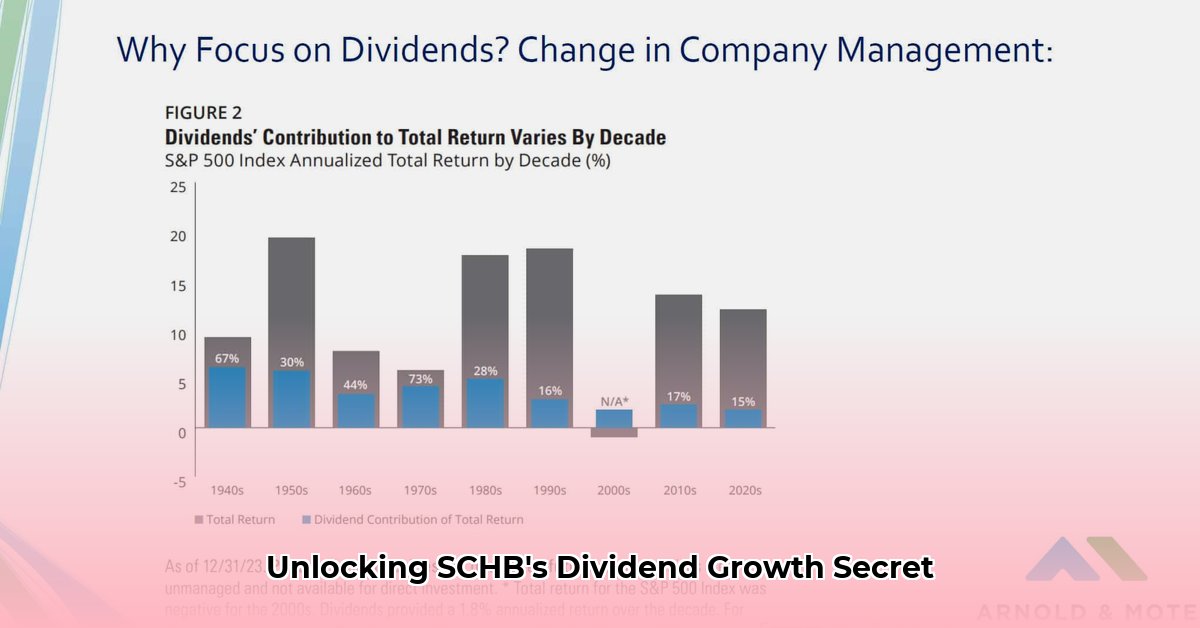
Understanding SCHB Dividends: A Simple Breakdown
The Schwab US Broad Market ETF (SCHB) offers diversified exposure to the U.S. stock market, providing a convenient way to own a piece of numerous companies. Since 2017, SCHB has consistently paid dividends, appealing to investors seeking a regular income stream alongside potential capital appreciation. However, its dividend yield is moderate, representing a consistent but not exceptionally high payout. This approach prioritizes reinvesting profits for long-term growth, a key factor to consider when evaluating SCHB's suitability for your investment goals.
Dissecting the Dividends: Growth, Payout, and the Big Picture
SCHB's dividend growth, while steady, has been moderate rather than explosive. For instance, a recent annual increase of 8.79% is promising but not exceptionally high compared to other ETFs. Its relatively low payout ratio—around 32.59%—suggests a focus on reinvesting profits for future growth rather than maximizing immediate dividend income. This approach is consistent with the fund's objective of achieving long-term capital appreciation. Is this balance of growth and income the right fit for you? Your individual risk tolerance and financial goals will determine the answer.
Tracking the Market: How Closely Does SCHB Follow the Pack?
SCHB aims to track the Dow Jones U.S. Broad Stock Market Index. To manage costs, SCHB employs a sampling methodology, meaning it doesn't invest in every company within the index. While this cost-effective approach may result in minor deviations between SCHB's performance and the index, the long-term impact is usually negligible. However, investors preferring precise index tracking might find this approach less desirable. The trade-off is a lower expense ratio. What's the right balance for you?
Is SCHB Right for You? Considering Your Individual Needs
The suitability of SCHB depends entirely on your investment goals and risk tolerance.
Long-Term Growth Investors: SCHB's reinvestment strategy aligns well with long-term growth objectives, making its moderate dividend yield less critical.
Income-Focused Investors: If regular income is your priority, SCHB's moderate dividend growth requires careful consideration. Compare its yield to higher-yielding alternatives, remembering diversification is key.
Navigating the Risks: A Realistic Look at the Potential Downsides
Like all investments, SCHB carries inherent risks. Understanding these risks is crucial for making informed investment decisions.
| Risk Factor | Likelihood | Potential Impact | Mitigation Strategies |
|---|---|---|---|
| Market Downturn | High | Significant | Diversification, dollar-cost averaging |
| Interest Rate Hikes | Moderate | Moderate | Portfolio adjustments, incorporating bonds |
| Tracking Error | Low | Minor | Monitor performance relative to the benchmark index; accept minor deviations |
| Regulatory Changes | Moderate | Moderate | Stay informed, consult a financial advisor |
Your Next Steps: A Practical Guide to Investing in SCHB
Thorough Research: Compare SCHB to similar ETFs based on expense ratios, investment strategy, and alignment with your goals.
Goal Alignment: Ensure SCHB's investment style matches your risk tolerance and objectives.
Diversification: Spread investments across various asset classes to mitigate risk.
Ongoing Monitoring: Regularly review your portfolio's performance and make necessary adjustments.
Disclaimer: This review provides general information and does not constitute financial advice. Consult a financial advisor before making investment decisions. Past performance is not indicative of future results.
How to Mitigate SCHB ETF Dividend Payout Ratio Risk
Key Takeaways:
- SCHB provides a history of consistent dividends with moderate growth. Its low payout ratio suggests financial strength; however, external factors affect dividend payouts.
- Market fluctuations are an inherent risk.
- Diversification and a clear understanding of risk tolerance are crucial considerations.
Understanding SCHB's Dividend Profile
SCHB's relatively low payout ratio indicates that a significant portion of its earnings are reinvested, enhancing the fund's long-term financial resilience. This approach prioritizes sustainable growth, although it may mean lower immediate dividend payouts.
Assessing the Risks: More Than Meets the Eye
The sampling methodology used by SCHB, while cost-effective, introduces a degree of tracking error. Furthermore, market volatility poses a universal risk, potentially impacting dividend payments.
How to Mitigate SCHB ETF Dividend Payout Ratio Risk
Mitigating risk focuses on external factors influencing the payout ratio:
Diversification: Spread your investments across asset classes to reduce reliance on any single investment.
Risk Tolerance: Align your investment strategy with your comfort level and risk appetite.
Long-Term Perspective: Focus on long-term income generation rather than short-term fluctuations.
Regular Monitoring: Track SCHB's performance and market conditions to make informed adjustments.
Consider Alternatives: Explore other ETFs or investment strategies as part of a well-diversified portfolio.
Comparing SCHB to Alternatives
A comparative analysis of SCHB with similar ETFs, considering expense ratios, past performance, and tracking error, is essential for informed investment decisions.